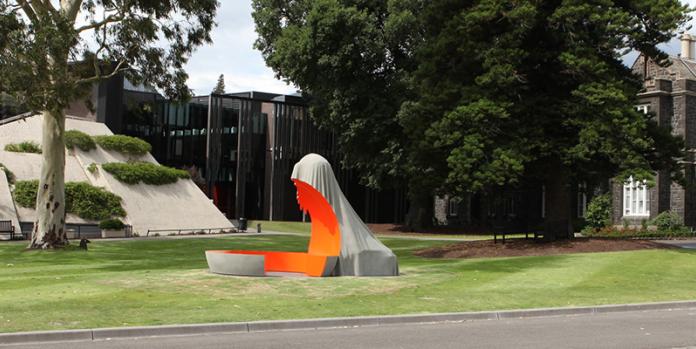The Sculpture Walk comprises six locations across the School’s South Yarra campus which are intended to house significant and diverse sculptures by contemporary artists.
The first commission for the Sculpture Walk is Cover Up # 18 by Callum Morton, an internationally acclaimed contemporary artist, an alumnus of the School and current Head of the Art Department at Monash University. The sculpture was unveiled on 29 January 2016.
The aim of the Sculpture Walk is to emphasise the importance of visual art and contemporary sculpture, and to encourage people to move on an artistic journey across the campus .
About Cover Up #18
Excerpt from Callum Morton’s speech, at the unveiling of Cover Up #18 in January 2016:
Cover Up #18 is part of a series of outdoor works I have created with my colleagues in the Monash Arts Projects office, that one might more accurately call ‘sculpture/furniture’ or in art world parlance ‘social sculpture’.
In general terms, the process for making these works is I locate a form that exists in the world that is in proximity or bears some direct relationship to the intended site of the work. I then have it 3D scanned, bring it into the computer as a virtual model and use software to cover or drape it with fabric. This form is then redesigned to house seating that responds directly to the context of the site before going to the factory.
For this work, I chose Peter Corlett’s sculpture Cobbers that sits at the foot of the Shrine on the corner of Domain and St Kilda Roads. I didn’t choose this work for any particular reason. I happened across it as I was wandering around the surrounding area wondering what to cover, and it seemed interesting on a number of levels, not least of which its relationship to the Shrine, which is indeed a grand spectre in this part of the city. I certainly liked that it was two figures, a multiple not an individual, which says much about schools and their communities. But simply I also liked the shape it formed when draped, which is a peculiarity and banality of an artist’s way of seeing the world.
Part of the idea of these outdoor works is that they expand the notion of how one might interact with art in public space. Interaction is, however a complex beast. I’m not as a rule fond of the rather simplistic idea of ‘interactive art’ as if work is somehow superior or more democratic because it enables observers to be a part of the work, and certainly the idea of ‘social sculpture’ contains elements of this rather simplistic view. Perhaps like me you have been in the theatre at one point or another, when half way through a performance, the lights come up and the actors tell us that this is the part of the show where the audience gets involved and you end up on stage feeling like an idiot when all you wanted was to do was sit in the dark and watch a performance.
Indeed, watching or looking remain as the fundamental types of interaction with art (indeed entire branches of aesthetic philosophy, and psychoanalysis are dedicated to it). To be sure it is not the only one of our senses that can be engaged but it remains crucial. The aesthetic quality of a work can simply invoke a feeling of pleasure, but it can also activate critical thought, and thinking about this work and its evolution is another vital form of interaction, particularly in the context here of a school. The idea that there is a covered form that is forever on the cusp of being revealed, whose definition is fluid and open, speaks to me about how the role of education, at whatever level, is to uncover the potential in every student.
Now looking and thinking can be done from a distance of course, but in this case, one is also encouraged to perform these interactions while sitting in and on the work. The circular seat provides room for one person or for many and is designed so that a group can occupy the seat facing each other internally, or rotate the other way and face outward to watch the world that is moving about them. The orange scoop cut out of the folds also doubles as a type of canopy, so the work operates as a mini cave or shelter and as such is a form of minor architecture. Now for all these lofty ambitions I describe here it is likely that one could not think of any of these things at all and simply regard it as a pretty cool seat.
